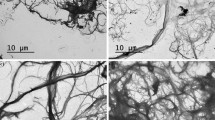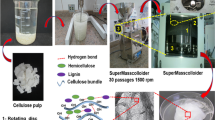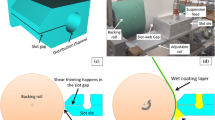Abstract
This study presents a comparison of the mechanical and barrier properties of papers coated with microfibrillated cellulose (MFC) by two different coating processes: (i) bar coating and (ii) size press. Due to the high water content of MFC, water-treated papers were taken as references to highlight the effects of MFC on the properties of papers. Structural, mechanical and barrier properties of the ensued materials were performed respectively with SEM, tensile and stiffness testers, and air and oxygen permeability equipments. The properties of the water-treated papers were considerably damaged compared to those of the base paper that underlined the negative impact of both coating processes on the papers structure. With MFC, the air barrier and the bending stiffness were considerably improved (+90 and +50 % respectively), especially when the bar coating was used, i.e. with 7 g m−2 of MFC. Size press was indeed not able to considerably improve papers properties as the MFC coat weight barely reached 4 g m−2 resulting from ten successive MFC layers.









Similar content being viewed by others
References
Zhang Z, Britt IJ, Tung MA (2001) Permeation of oxygen and water vapor through EVOH films as influenced by relative humidity. J Appl Polym Sci 82(8):1866–1872
López-Rubio A, Lagarón JM, Hernández-Muñoz P, Almenar E, Catalá R, Gavara R, Pascall MA (2005) Effect of high pressure treatments on the properties of EVOH-based food packaging materials. Innov Food Sci Emerg Technol 6(1):51–58
Choi JO, Jitsunari F, Asakawa F, Park HJ, Lee DS (2002) Migration of surrogate contaminants in paper and paperboard into water through polyethylene coating layer. Food Addit Contam 19(12):1200–1206
Touey GP (1962) Petroleum wax for paper coatings. Kingsport, Tennessy Patent US 3,053,677
Wu Y, Duan H, Yu Y, Zhang C (2001) Preparation and performance in paper coating of silicone-modified styrene–butyl acrylate copolymer latex. J Appl Polym Sci 79(2):333–336
Duan H, Zhao C, Wu Y, Zhang Q, Wang S (1999) Performance in paper coating of styrene/acrylate copolymer latex. Polym Adv Technol 10(1–2):78–81
Khwaldia K, Arab-Tehrany E, Desobry S (2010) Biopolymer coatings on paper packaging materials. Comp Rev Food Sci Food Saf 9(1):82–91
Han J, Sp Salmieri, Le Tien C, Lacroix M (2010) Improvement of water barrier property of paperboard by coating application with biodegradable polymers. J Agric Food Chem 58(5):3125–3131
Gällstedt M, Brottman A, Hedenqvist MS (2005) Packaging-related properties of protein- and chitosan-coated paper. Packag Technol Sci 18(4):161–170
Kjellgren H, Gällstedt M, Engström G, Järnström L (2006) Barrier and surface properties of chitosan-coated greaseproof paper. Carbohydr Polym 65(4):453–460
Ham-Pichavant F, Sèbe G, Pardon P, Coma V (2005) Fat resistance properties of chitosan-based paper packaging for food applications. Carbohydr Polym 61(3):259–265
Fringant C, Rinaudo M, Gontard N, Guilbert S, Derradji H (1998) A biogradable starch based coating to waterproof hydrophilic materials. Starch 50(7):292–296
Yan Z, Liu Q, Deng Y, Ragauskas A (2005) Improvement of paper strength with starch modified clay. J Appl Polym Sci 97(1):44–50
Rhim J-W, Lee J-H, Hong S-I (2006) Water resistance and mechanical properties of biopolymer (alginate and soy protein) coated paperboards. LWT Food Sci Technol 39(7):806–813
Herrick FW, Casebier RL, Hamilton JK, Sandberg KR (1983) Microfibrillated cellulose: morphology and accessibility. J Appl Polym Sci 37:797–813
Turbak AF, Snyder FW, Sandberg KR (1985) Micro-fibrillated cellulose and process for producing it. Patent No. CH 648071 (A5)
Siró I, Plackett D (2010) Microfibrillated cellulose and new nanocomposite materials: a review. Cellulose 17(3):459–494
Siqueira G, Bras J, Dufresne A (2009) Cellulose whiskers versus microfibrils: influence of the nature of the nanoparticle and its surface functionalization on the thermal and mechanical properties of nanocomposites. Biomacromolecules 10(2):425–432
Syverud K, Stenius P (2009) Strength and barrier properties of MFC films. Cellulose 16(1):75–85
Fukuzumi H, Saito T, Iwata T, Kumamoto Y, Isogai A (2009) Transparent and high gas barrier films of cellulose nanofibers prepared by TEMPO-mediated oxidation. Biomacromolecules 10(1):162–165
Lavoine N, Desloges I, Dufresne A, Bras J (2012) Microfibrillated cellulose—its barrier properties and applications in cellulosic materials: a review. Carbohydr Polym 90:735–764
Hult EL, Iotti M, Lenes M (2010) Efficient approach to high barrier packaging using microfibrillar cellulose and shellac. Cellulose 17(3):575–586
Aulin C, Gällstedt M, Lindström T (2010) Oxygen and oil barrier properties of microfibrillated cellulose films and coatings. Cellulose 17(3):559–574
Nygårds S, Aulin C, Ström G (2011) Nanocellulose in pigment coatings—aspects of barrier properties and printability in offset. Master‘s Thesis, Linkö** University and Invenntia AB, Sweden
Hamada H, Beckvermit J (2010) Bousfield W D Nanofibrillated Cellulose with Fine Clay as a Coating Agent to Improve Print Quality. PaperCon 2010 Conference. Atlanta, USA, p 11
Luu T W, Richmond F, Bilodeau M, Bousfield WD (2011) Nano-fibrillated cellulose as a paper surface treatment for inkjet printing. In: 2011 TAPPI international conference on nanotechnology for renewable materials, Arlington
Lavoine N, Desloges I (2011) Bras J Impact of different coating processes of MFC on barrier and mechanical properties. TAPPI International Conference on Nanotechnology for Renewable Materials. Arlington, USA, p 38
Bardet R, Lavoine N, Desloges I, Belgacem MN, Bras J (2012) Barrier properties of specialty papers coated with microfibrillated cellulose: influence of base paper and coat weight. Paper presented at the 2012 TAPPI international conference on nanotechnology for renewable materials, Montreal
Pääkkö M, Ankerfors M, Kosonen H, Nykänen A, Ahola S, Österberg M, Ruokolainen J, Laine J, Larsson PT, Ikkala O, Lindström T (2007) Enzymatic hydrolysis combined with mechanical shearing and high-pressure homogenization for nanoscale cellulose fibrils and strong gels. Biomacromolecules 8(6):1934–1941
Iotti M, Gregersen ØW, Moe S, Lenes M (2010) Rheological studies of microfibrillar cellulose water dispersions. J Polym Environ 19(1):137–145
Puisto A, Illa X, Mohtaschemi M, Alava MJ (2012) Modeling the viscosity and aggregation of suspensions of highly anisotropic nanoparticles. Eur Phys J C7-6 35(1):1–7
Rezayati Charani P, Dehghani-Firouzabadi M, Afra E, Shakeri A (2013) Rheological characterization of high concentrated MFC gel from kenaf unbleached pulp. Cellulose 20(2):727–740
Fall AB, Lindström SB, Sundman O, Ödberg L, Wagberg L (2011) Colloidal stability of aqueous nanofibrillated cellulose dispersions. Langmuir 27(18):11332–11338
Lowys MP, Desbrières J, Rinaudo M (2001) Rheological characterization of cellulosic microfibril suspensions. Role of polymeric additives. Food Hydrocoll 15(1):25–32
Chinga-Carrasco G, Yu Y, Diserud O (2011) Quantitative electron microscopy of cellulose nanofibril structures from Eucalyptus and Pinus radiata kraft pulp fibers. Microsc Microanal 17(4):563–571. doi:10.1017/S1431927611000444
Hamada H, Bousfield WD (2010) Nano-fibrillated cellulose as a coating agent to improve print quality of synthetic fiber sheets. In: TAPPI 11th advanced coating fundamentals symposium, Munich
Chinga-Carrasco G, Syverud K (2012) On the structure and oxygen transmission rate of biodegradable cellulose nanobarriers. Nanoscale Res Lett 7:192
Kulachenko A, Denoyelle T, Galland S, Lindström S (2012) Elastic properties of cellulose nanopaper. Cellulose 19(3):793–807
Aulin C (2009) Novel oil resistant cellulosic materials. Doctoral Thesis in Pulp and Paper Industry, KTH Chemical Science and Engineering, Stockholm
Acknowledgements
The authors would like to thank Sandra Tapin-Lingua (FCBA, France) for her supply in MFC suspension and the characterization of the suspension (FE-SEM, light optical microscope and TEM analyses), and also gratefully acknowledge Cécile Sillard (LGP2, France) for the AFM images of the MFC-coated paper samples and Dr. Karim Missoum (Start-up INOFIB, Grenoble, France) for the picture of the MFC suspension.
Author information
Authors and Affiliations
Corresponding author
Rights and permissions
About this article
Cite this article
Lavoine, N., Desloges, I., Khelifi, B. et al. Impact of different coating processes of microfibrillated cellulose on the mechanical and barrier properties of paper. J Mater Sci 49, 2879–2893 (2014). https://doi.org/10.1007/s10853-013-7995-0
Received:
Accepted:
Published:
Issue Date:
DOI: https://doi.org/10.1007/s10853-013-7995-0




